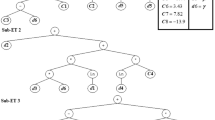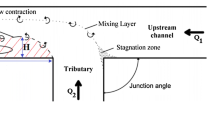Abstract
Manning’s roughness coefficient (n) has been widely used in the estimation of flood discharges or depths of flow in natural channels. Accurate estimation of Manning’s roughness coefficient is essential for the computation of flow rate, velocity. Conventional formulae that are greatly based on empirical methods lack in providing high accuracy for the prediction of Manning’s roughness coefficient. Consequently, new and accurate techniques are still highly demanded. In this study, gene expression programming (GEP) is used to estimate the Manning’s roughness coefficient. The estimated value of the roughness coefficient is used in Manning’s equation to compute the flow parameters in open-channel flows in order to carry out a comparison between the proposed GEP-based approach and the conventional ones. Results show that computed discharge using estimated value of roughness coefficient by GEP is in good agreement (±10%) with the experimental results compared to the conventional formulae (R 2 = 0.97 and RMSE = 0.0034 for the training data and R 2 = 0.94 and RMSE = 0.086 for the testing data).


Similar content being viewed by others
References
Ab. Ghani A, Zakaria NA, Chang CK, Ariffin J, Abu Hasan Z, Abdul Ghaffar AB (2007) Revised equations for Manning’s coefficient for sand-bed rivers. Int J River Basin Manag 5(4):329–346
Alavi AH, Ameri M, Gandomi AH, Mirzahosseini MR (2011) Formulation of flow number of asphalt mixes using a hybrid computational method. Constr Build Mater 25(3):1338–1355
Altun H, Bilgil A, Fidan CF (2006) Treatment of multi-dimensional data to enhance neural network estimators in regression problems. Expert Syst Appl 32(2):599–605
Azamathulla HMd, Ahmad Z (2012) Gene-expression programming for transverse mixing coefficient. J Hydrol 434–435:142–148
Azamathulla HMd, Deo MC, Deolalikar PB (2008) Alternative neural networks to estimate the scour below spillways. Adv Eng Softw 39(8):689–698
Barnes HH Jr (1967) Roughness characteristics of natural channels. US Geological Survey Water-Supply Paper 1949
Bilgil A (1998) The effect of wall shear stress on friction factor in smooth open channel flows. Ph.D. Thesis. Karadeniz Technical University, Trabzon (Turkey) (in Turkish)
Bilgil A, Altun H (2008) Investigation of flow resistance in smooth open channels using artificial neural networks. Flow Meas Instrum 19:404–408
Çiray, C. (1999) On some special corner flows (with emphasis on uniform flows in rectangular channels), Memorial Volume of L. Prof. Dr. K. Çeçen, Faculty of Civil Engineering, ÏTÜ
Chow VT (1959) Open channel hydraulics. McGraw-Hill Book Co, New York
Dingman SL, Sharma KP (1997) Statistical development and validation of discharge equations for natural channels. J Hydrol 199:13–35
Dooge JCI (1991) The Manning formula in context channel flow resistance; centennial of Manning’s formula. Water Resources Publications, Littleton (Colo), pp 136–185
Ferreira C (2001) Gene expression programming in problem solving. In: 6th online world conference on soft computing in industrial applications (invited tutorial)
Ferreira C (2001) Gene expression programming: a new adaptive algorithm for solving problems. Complex Syst 13(2):87–129
French RH (1985) Open channel hydraulics. McGraw-Hill, New York
Gandomi AH, Alavi AH, Mirzahosseini MR, Moqhadas Nejad F (2011) Nonlinear genetic-based models for prediction of flow number of asphalt mixtures. J Mater Civ Eng 23(3):248–263
Gandomi AH, Babanajad SK, Alavi AH, Farnam Y (2012) A novel approach to strength modeling of concrete under triaxial compression. J Mater Civil Eng (in press). doi:10.1061/(ASCE)MT.1943-5533.0000494
Gandomi AH, Tabatabaie SM, Moradian MH, Radfar A, Alavi AH (2011) A new prediction model for load capacity of castellated steel beams. J Constr Steel Res 67(7):1096–1105
Gandomi AH, Alavi AH (2011) Multi-stage genetic programming: a new strategy to nonlinear system modeling. Inf Sci 181(23):5227–5239
GEPSOFT (2006) GeneXproTools. Version 4.0. http://www.gepsoft.com
Giustolisi O (2004) Using genetic programming to determine Chèzy resistance coefficient in corrugated channels. J Hydroinform 6(3):157–173
Green JC (2006) Effect of macrophyte spatial variability on channel resistance. Adv Water Resour 29:426–438
Guven A, Aytek A (2009) A new approach for stage-discharge relationship: gene-expression programming. J. Hydrologic Eng 14(8):812–820
Guven A, Gunal M (2008a) Genetic programming approach for prediction of local scour downstream of hydraulic structures. J Irrig Drain Eng 134(2):241–249
Guven A, Gunal M (2008b) Prediction of scour downstream of grade-control structures using neural networks. J Hydraul Eng 134(11):1656–1660
Henderson FM (1966) Open channel flow. MacMillan Co, New York
Hicks DM, Mason PD (1991) Roughness characteristics of New Zealand rivers. Water Resources Survey, Wellington
Jarrett RD (1984) Hydraulics of high gradient streams. ASCE J Hydraul Eng 110:1519–1539
Jiang M, Li L-X (2010) An improved two-point velocity method for estimating the roughness coefficient of natural channels. Phys Chem Earth Parts A/B/C 35(3–5):182–186
Kazemipour AK, Apelt CJ (1982) Shape effects on resistance to uniform flow in open channels. J Hydraul Res 17:129–147
Keulegan GH (1938) Laws of turbulent flow in open channels. J Natl Bureau Stand 1151(21):707–741
Koza JR (1999) Genetic programming: on the programming of computers by means of natural selection. The MIT Press, Cambridge, MA
Riggs HC (1976) A simplified slope area method for estimating flood discharges in natural channels. J Res US Geol Survey 4:285–291
Solomatine DP, Otsfeld A (2008) Data-driven modelling: some past experiences and new approaches. J Hydroinform 10(1):3–22
Myers WRC (1982) Flow resistance in wide rectangular channels. J Hydraul Div ASCE 108:471–482
Powell RW (1970) Resistance studies on smooth open channels. J Hydraul Div ASCE 364–367
Pillia NN (1970) On uniform flow through smooth rectangular open channels. J Hydraul Res 8:403–417
Pillia NN (1997) Effect of shape on uniform flow through smooth rectangular open channels. Journal of Hydraulics Research 8:655–658
Rahman HK, Williams JR, Wormleaton PR (1997) Identification problem of open channel friction parameters. J Hydraul Res 8:1078–1088
Rao KK (1969) Effect of shape on the mean-flow characteristics of turbulent flow through smooth rectangular open channel. PhD Thesis presented to the University of Iowa at Iowa City, Iowa
Reinus E (1961) Steady uniform flow in open channels transactions. Royal Institute Technology, Stockholm, p 179
Syamala P (1998) Velocity shear and friction studies in smooth rectangular channels of small aspect ratio for supercritical flows, PhD Thesis presented to the Indian Institute of Science at Bangalore, India
Tinkler KJ (1997) Critical flow in rockbed streams with estimated values for Manning’s n. Geomorphology 20:147–164
Tracy HJ, Lester CM (1961) Resistance coefficients and velocity distribution-smooth rectangular channel. US Geol Surv Water Supply Paper 1592-A, pp 1–18
Wilson C (2007) Flow resistance models for flexible submerged vegetation. J Hydrol 342(3–4):1213–1222
Yen BC (2002) Open channel flow resistance. J Hydraul Eng 128:20–39
Acknowledgments
The authors wish to thank Dr. Halis Altun, Coordinator of Intelligent Signal Processing and Interface Technologies Laboratory Embedded System Laboratory, Nigde University Engineering Faculty, Department of Electrical and Electronic Engineering, 51245, Kampus, Nigde, Turkey, for providing the data and suggestions on preparation of this manuscript.
Author information
Authors and Affiliations
Corresponding author
Rights and permissions
About this article
Cite this article
Azamathulla, H.M., Ahmad, Z. & Ab. Ghani, A. An expert system for predicting Manning’s roughness coefficient in open channels by using gene expression programming. Neural Comput & Applic 23, 1343–1349 (2013). https://doi.org/10.1007/s00521-012-1078-z
Received:
Accepted:
Published:
Issue Date:
DOI: https://doi.org/10.1007/s00521-012-1078-z




